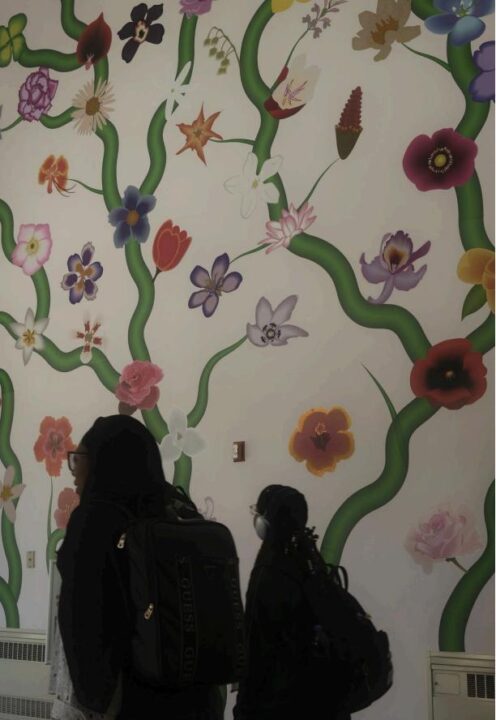Rina Sawayama has always been bold. She first adapted to the temperaments of London after moving from Japan at the age of 5, then made it in a tough industry with no support by going from uploading songs on Myspace to releasing her debut album, SAWAYAMA, in 2020. Now, she has released one of 2022’s boldest albums, Hold the Girl.
SAWAYAMA was a cohesive but randomized medley of all genres conceivable. It seamlessly transitions from soulful glam metal with the introductory track, “Dynasty,” to arguably the most fun critique of excessive consumption with the aptly titled “XS.” Her brand is bold. And with her latest album, Hold the Girl, this trait of boldness takes on a newer, perhaps more gentle form, one that asks for catharsis and forgiveness.
Stemming from the pandemic, Hold the Girl operates as an undulating therapy session similar to the ones that Sawayama underwent during lockdown. However, instead of being a solely emotional and burdensome event, Sawayama graces it with a sparkling late 90s and early 2000s flair reminiscent of Shania Twain and The Goo Goo Dolls all at the same time.
As an article on Shondaland.com states, “Between the lines [of her music] the narrative emerged: I am not going to be defined by you. I won’t stick to one genre. I won’t be an easily classifiable, perfectly packaged commodity.”
Under the guise of catchy and cohesive sounds you are sure you could hear at a college dance party, the 32-year-old singer finds a way to “re-parent” her younger self, diss her conservative Christian school, embrace being a sinner and face “eternal damnation” rather than subdue herself and her pansexual identity – something she struggled to come to terms with for a large part of her life.
Hold the Girl is formed like an arc with the earlier half dealing with the aggression and violence that unresolved trauma breeds. In the intro ballad “Minor Feelings,” named after Korean-American poet Cathy Park Hong’s book about the marginalization of Asian American experiences, Sawayama brilliantly ties her microcosmic experience of being barred from doing things in her childhood to the larger experiences of lack of security and prejudices faced by the Asian community, especially against the backdrop of the COVID-19 pandemic which saw a staggering increase in violent misconceptions and attacks against Asians across the world.
This is soon accompanied by the title track, Hold the Girl, produced by Barney Lister and synthesized as an indie dance-beat on the simple refrain, “Reach inside and hold you close. / I won’t leave you on your own. / Teach me the words I used to know. / Yeah, I forgot them years ago.” This may as well be the ethos of the entire album: reconciling with the past to move on to a healed future. Accompanied by a church-like chorus in its bridge, Sawayama effectively places her past in the hands of the listener and gives listeners a chance to join in and heal her through the same refrain.
This arc of faith and healing further transforms into a dissent of religion with the sparkly lead single, “This Hell.” Arguably the most SAWAYAMA-esque song of Hold the Girl, “This Hell” is a dazzling country rock fusion with a sampling of ABBA that asks listeners to join the dissent all the way to Satan’s ballroom where they can celebrate queer icons like Britney Spears, Whitney Houston and Princess Diana and find a community to feel proud to be damned in. A direct opposition to the Westboro Baptist Church, the song, as well as many others on the album, espouses the idea of finding one’s truest, and at times queerest, self within the deepest level of Dante’s Inferno.
While “This Hell” seems like a direct descendant of the artist’s last album, it is an outlier in Hold the Girl. The rest of the album focuses on rationalizing Rina and more importantly, letting her be the one doing it. Songs like “Forgiveness” and the somber “Send my love to John” allow the artist to deal with different stages of healing. The former is perhaps the best recapitulation of the varied process of forgiveness. Laid like a Mazzy Star track, the song identifies the pain of hurting beyond retribution and rationalizes the time that said forgiveness can take and serves as a reminder to her and all of her listeners to not let vengeance take over so easily.
The latter song, however, puts Rina in the completely different position of an immigrant parent coming to terms with their child being queer, making for one of the most heartfelt songs released in a while. Completely stripped of any hyper-pop beats and orchestral production, the song is instead an acoustic voicemail to the partner of an immigrant mother’s gay son seeking forgiveness and hoping for a brighter future. This song has particularly resonated with members of the LGBTQ+ community who have felt the song is a cathartic experience and gives many the chance to experience a feeling that they may not.
Through the course of her career, Sawayama has exemplified creation through adversity. She uses her past not to make great art from the pain, but rather through the process of healing, a heartbreaking yet life-affirming process. In her final track and bookend to the arc, “To be Alive,” Rina puts the entire album in perspective. Through the song, she recognizes that pain does not have to beget more pain or that “Flowers still look pretty when they’re dying.” Like a mantra, she reaffirms herself over and over again, acknowledging what pain can take away and the things even trauma cannot soil.
Hold the Girl is a mature and cathartic progression in Rina Sawayama’s body of work. Through the psychedelic beats, disco synths and soft ballads, she shows a command and mastery of her own story and the story she wants to present to her listeners, and hopefully allows them to go on a similar journey to absolution as she did. With her sophomore feature, she has proved herself to be a formidable force in the industry and a name in pop that will live on for years to come.
Rima Sawayama performs onstage. Photo courtesy of Wikimedia Commons.
Ash Shehzad is a sophomore Psychology major and Arts & Culture Editor. Contact Ash at ayeshas1@umbc.edu.


